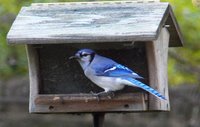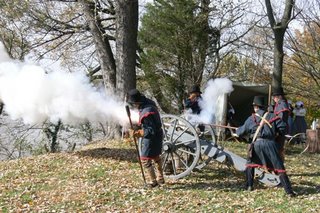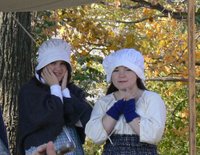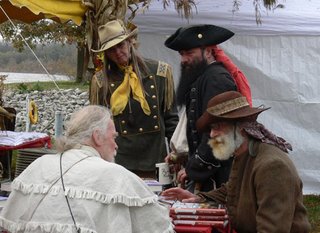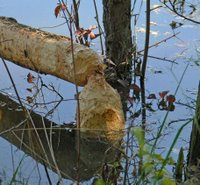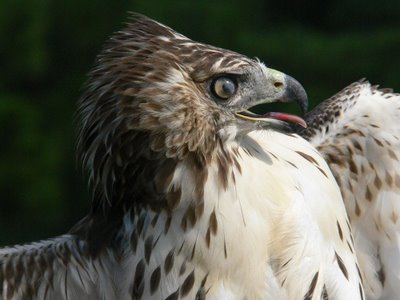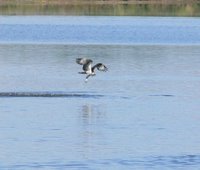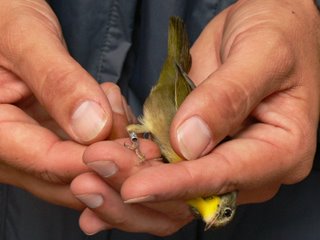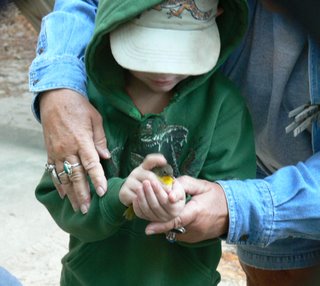
One expects to see large birds on an Eagles Weekend and the Bald Eagles and Snow Geese certainly meet that expectation. However, by walking around a bit, we also saw many different smaller birds, some very familiar, and others which were a first sighting for us.
I particularly noticed the number of birds having "red" in their names. The wetlands near the Kentucky Forestry Dept. tree nursery at Kentucky Dam Village is an approachable cypress swamp.

The edge of the lake is surrounded by brush, and the shallow water held a light coat of ice early in the morning, but the
Redwinged Blackbirds were out in force. They must have some sort of camera radar, because every time I focused on one, it flew just out of sight and started singing again. The classic red bird, the Northern Cardinal, also avoided having its picture taken as long as possible. I have four different pictures of the place where the Cardinal
had been a second earlier. Do you think they can hear the
auto focus on the camera? Maybe that's why I don't have many Cardinal pictures from my backyard. The Eastern Bluebird is abundant at the Park too. Even though they don't have "red" in their name, they certainly have a
roufous belly, which surprises many people

The Red-headed Woodpecker, on the other hand, loves to have its picture taken. Almost every time we heard a rat-tat-tat up in a tree, it was a Red-headed Woodpecker. Unless, of course, it was a Red-Bellied Woodpecker! I rarely see Red-headed Woodpeckers at home,

so it was a delight to find so many of them at the park. The Red-tailed Hawks perched on the branches along each road we drove. Sometimes what we thought was an Eagle at first turned out to be a Red-tailed Hawk soaring overhead instead. When they bank to the side, that tail glows in a burnt orange color. Of course, I had no luck catching a wild one in my lens, but the one at the raptor program didn't blink an eye when all those flashes went off in his face. He looks rather disdainful of the process.
The ducks and other waterfowl were also a bit camera shy. At the tree nursery, we could see through the brush with binoculars and found many ducks we've never seen before, including

Common
Goldeneye (their eyes really are golden, even from a distance). The stark black and white pattern of the
Bufflehead was identifiable from across the lake. Flights of Canadian Geese circled then splashed to a landing. The black rump feathers of the
Gadwall stood out for another first sighting. We saw some Ring-Necked Ducks, and I feel confident that Lesser
Scaup were also on the lake that chilly morning. This photo is a Ring-Necked Duck, not a Golden-Eye as I originally thought from a distance. We don't see a lot of ducks at the Falls of the Ohio, so this was very exciting for me. I half expected to find some Northern
Shovelers, but didn't recognize them if they swam with the other ducks. If the brush hadn't been so thick, or if there has been an observation deck, the spotting scope would have given us a better view. More importantly, I could have had much closer photos of the ducks. Ah well, someday I'll have that big lens, and then the small birds won't escape so easily.

 Ducks like to sit in the middle of the lake where I can't get a close picture of them. Today I learned that if I can see them well enough for a good photo, they can see me. Wild ducks are very flighty, and will take off on the slightest hint that someone is coming. Geese don't have that problem, and will pose nicely for anyone who wants their picture. I finally got smart when I found three Hooded Mergansers in a secluded pond.
Ducks like to sit in the middle of the lake where I can't get a close picture of them. Today I learned that if I can see them well enough for a good photo, they can see me. Wild ducks are very flighty, and will take off on the slightest hint that someone is coming. Geese don't have that problem, and will pose nicely for anyone who wants their picture. I finally got smart when I found three Hooded Mergansers in a secluded pond. There were two males and one female, so I figure some heavy duty courting was going on. I walked on the downstream side of the dam until I was just about even with them. They were busy enough that they didn't notice me for quite a while, and I got some good photos.
There were two males and one female, so I figure some heavy duty courting was going on. I walked on the downstream side of the dam until I was just about even with them. They were busy enough that they didn't notice me for quite a while, and I got some good photos.  The Turkey Trail is only a mile long, so I set out on it. Muscatatuck has so many water fowl because they have lots of water. They flood the moist soil units in the winter to be sure there is enough water, so any trail gets marshy at least in spots. Winter is a good time to hike in these areas. If it is cold enough to freeze the muddy spots, you can walk over them without sinking in up to your ankles! I did have to take a few detours when the path was completely flooded though. I didn't expect to see any snakes in this weather, and when one was stretched across the path, I was surprised to say the least. A quick picture was followed by a gentle prod with a stick to see if it was alive. The whole body lifted up, and I must conclude that it was frozen.
I heartily recommend the bookshop at the Visitor's Center. They have a wider variety of nature books than any park or refuge I have ever seen. They also had terrific photos as posters or post cards, which were taken by a photographer named Mark Trabue. Many of the photos I saw at the NWR can be seen (and probably purchased) online as well.
The Turkey Trail is only a mile long, so I set out on it. Muscatatuck has so many water fowl because they have lots of water. They flood the moist soil units in the winter to be sure there is enough water, so any trail gets marshy at least in spots. Winter is a good time to hike in these areas. If it is cold enough to freeze the muddy spots, you can walk over them without sinking in up to your ankles! I did have to take a few detours when the path was completely flooded though. I didn't expect to see any snakes in this weather, and when one was stretched across the path, I was surprised to say the least. A quick picture was followed by a gentle prod with a stick to see if it was alive. The whole body lifted up, and I must conclude that it was frozen.
I heartily recommend the bookshop at the Visitor's Center. They have a wider variety of nature books than any park or refuge I have ever seen. They also had terrific photos as posters or post cards, which were taken by a photographer named Mark Trabue. Many of the photos I saw at the NWR can be seen (and probably purchased) online as well.
























